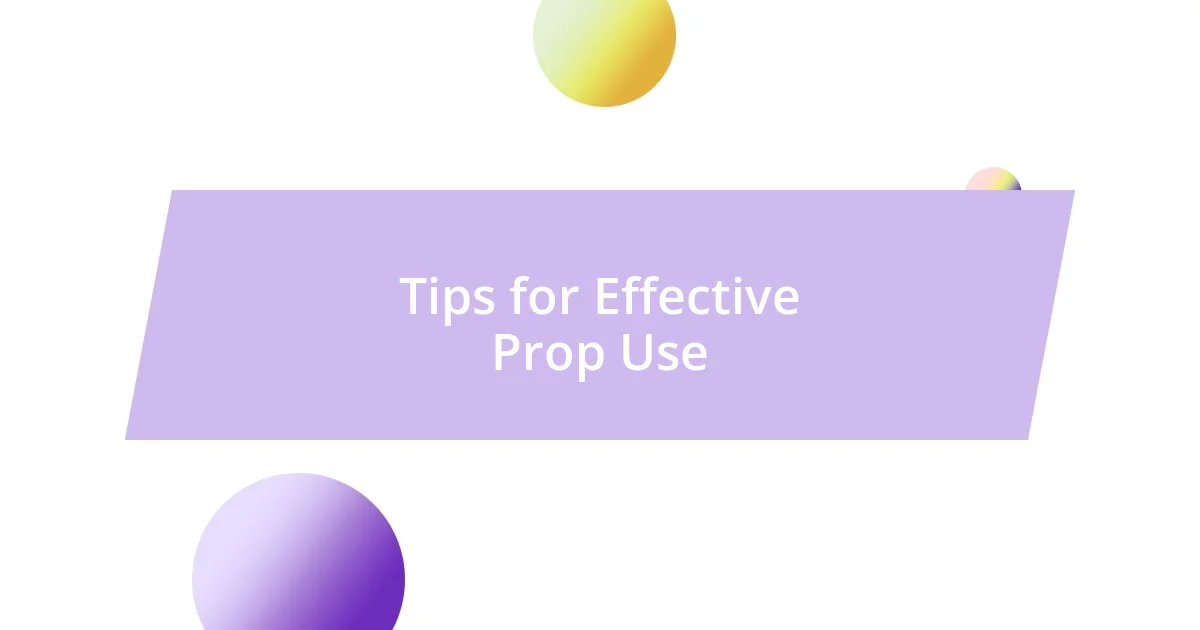Key takeaways:
- Props enhance communication by creating emotional connections and making abstract concepts tangible, significantly engaging the audience.
- Selecting the right props involves considering relevance, simplicity, emotional resonance, visibility, and personal stories to deepen audience engagement.
- Effective use of props bridges theory and reality while fostering inclusive dialogue and reflection, creating a meaningful connection between the speaker and audience.

Understanding the Role of Props
Props serve as powerful tools that enhance communication in any presentation or theatrical performance. I remember a time when I used a simple cardboard cutout to illustrate a point during a workshop. The moment it came into view, I noticed the audience’s eyes light up; it brought an abstract concept to life, proving how a visual aid could trigger engagement.
Think about how props can also generate emotional connections. When I integrated family photos into a storytelling session, the audience shared in my nostalgia. It was fascinating to see how something so personal can foster a sense of community and shared experience among attendees. Wouldn’t you agree that when we include meaningful items, we create richer narratives?
Moreover, props can serve as anchors in our presentations, helping audiences remember key messages. I often use a unique object to symbolize a theme, and it sticks with people long after they’ve left the room. Isn’t it remarkable how a single item can encapsulate complex ideas and evoke lasting memories?

Choosing the Right Props
When it comes to choosing the right props, I always consider the story I want to tell. For instance, during a motivational speech, I once brought a small, weathered compass. It wasn’t just an object; it symbolized guidance and direction, perfectly aligning with my message about navigating life’s challenges. The audience didn’t just see a prop; they felt a connection to their own journeys.
Here are some tips I follow when selecting props:
- Relevance: Ensure the prop directly relates to your message. A cluttered backdrop can distract rather than enhance.
- Simplicity: Sometimes, less is more. A single, powerful item often leaves a stronger impression than multiple props.
- Emotional resonance: Choose items that evoke feelings. A nostalgic object can trigger memories that deepen engagement.
- Visibility: Make sure your props are easily seen. Even the most meaningful item loses its impact if the audience can’t appreciate it.
- Personal stories: Share your connection to the prop. When I revealed the story behind the compass, it transformed the object into a shared experience.

Designing with Meaningful Props
When I think about designing with meaningful props, I reflect on how each item can distinctly shape the atmosphere of a presentation. For example, I once used a vintage suitcase in a travel-themed talk. Its worn leather and old stickers sparked curiosity and nostalgia, instantly transporting the audience into the world I was describing. Who wouldn’t be intrigued by the stories that an old suitcase might hold? This connection turned a simple object into a vessel of imagination, enhancing the overall experience.
The significance of props also comes from their ability to bridge gaps in understanding. In a recent discussion about change, I incorporated a flickering lantern. Its warm light symbolized hope, illuminating the path ahead while simultaneously reminding everyone of their capacity to navigate the dark. This not only facilitated deeper comprehension but also forged emotional ties, encouraging the audience to reflect on their own journeys in relation to the theme.
Lastly, I believe that meaningful props help create a lasting impression. During a pitch for a community project, I presented a handmade item crafted by local artisans. The prop embodied the very essence of the project and resonated with the audience on multiple levels. It wasn’t merely about showcasing the work; it was about honoring the stories and lives behind it. Such inclusivity fosters an emotional response, encouraging a shared investment in the message.
| Aspect | Example Prop |
|---|---|
| Imagery | Vintage suitcase |
| Emotional Tie | Flickering lantern |
| Community Connection | Handmade artisan item |

Enhancing Storytelling with Props
When I think about enhancing storytelling through props, I can’t help but recall an event where I used a simple jar of sand during a discussion on life’s complexities. Holding that jar, I asked the audience to imagine each grain representing a moment in their lives. Suddenly, something as ordinary as sand turned into a profound metaphor, inviting each person to reflect on the multitude of experiences that shape who they are. It was a beautiful moment of connection.
Another time, I employed a weathered book filled with old photographs during a presentation about preserving memories. The instant I passed around the book, a hush fell over the audience. I saw their eyes light up, as each picture brought forth their own treasured recollections. It’s fascinating how an object can evoke such powerful emotions and spark individual stories in a shared space.
I also remember using a simple tool, a hammer, while discussing the theme of resilience. I struck a surface lightly, creating a sound that caught everyone’s attention. With each bang, I likened it to the challenge of overcoming obstacles, emphasizing how it takes repeated efforts to build something meaningful. Props like these aren’t just supportive elements; they become integral parts of the narrative, inviting people to engage and immerse themselves in the experience. Don’t you think a well-chosen prop can transform a message into something memorable?

Incorporating Props in Practice
In my experience, using props in practice can be a game-changer. During a workshop on innovation, I brought along a broken clock. As I held it up, I explained how time often feels like it’s standing still when we’re stuck in our routines. The clock’s cracked face reminded everyone that it’s okay to break free and embrace change, sparking a lively discussion about our own barriers. Doesn’t a simple object like that compel us to think differently?
I also find that the physicality of props engages the audience in a way that words sometimes can’t. One time at a conference, I passed around a handful of seeds during a session about growth and potential. Each participant held a seed, visualizing the journey from tiny beginnings to flourishing plants. It was a visceral experience that made the concept of growth far more tangible and personal. Isn’t it fascinating how something so small can hold such grand possibilities?
Finally, the use of props often invites authenticity into the dialogue. I vividly recall using a small, vibrant painting while discussing creativity. As the audience gazed at it, I encouraged them to share their interpretations. The room buzzed with spontaneous insights and laughter, creating an inclusive atmosphere where everyone felt valued. It’s moments like these that remind me: props not only support our messages but also weave connections between us, transforming a monologue into a meaningful conversation.

Evaluating Impact of Props
Evaluating the impact of props often means reflecting on the emotional responses they evoke. I remember using a colorful scarf during a talk about identity. As I draped it over my shoulders, I felt a wave of vulnerability wash over me. This simple act allowed me to express that our identities are multi-layered, prompting attendees to share their own stories. Isn’t it remarkable how an object can serve as a catalyst for such profound discussion?
When assessing the effectiveness of props, I think about their ability to create visual cues that enhance comprehension. Once, while discussing the concept of teamwork, I placed a puzzle piece on the table. Each participant could see how they fit into a larger picture. The moment sparked a collective realization: without each piece, the puzzle remains incomplete. Doesn’t this just illustrate how essential our roles are in collaborative efforts?
Finally, I often consider how props can bridge the gap between theory and reality. At a seminar on environmental awareness, I brought an empty plastic bottle, symbolizing waste. As I held that bottle aloft, the atmosphere shifted palpably; everyone became more attentive. They were confronted with a tangible representation of a broader issue. How often do we reflect on our impact through something so mundane? This awareness can ignite a transformation not just in thought, but in action.

Tips for Effective Prop Use
Using props effectively goes beyond their physical presence; it’s also about how they resonate with the audience. Once, I incorporated a piece of string to illustrate the concept of connections in relationships. As I held it up, I challenged participants to consider the strength and fragility of their ties with others. The visual metaphor really struck a chord, prompting shared stories that brought us together. Isn’t it intriguing how a simple prop can unravel deep connections between us?
To elevate your props, think about the emotional energy they evoke. In a session focused on personal growth, I used a worn-out book—my own journal filled with scribbled thoughts and sketches. Sharing its history created a sense of vulnerability and honesty, allowing others to feel safe in voicing their struggles. Have you ever noticed how a tangible element can cultivate a space of trust and openness?
Lastly, remember that props should serve a purpose, not distract from your message. I once brought in a quirky hat during a brainstorming activity, which was meant to inspire creativity. However, halfway through, I realized it was taking too much attention away from our discussion. So, while props can be fun, they should enhance your communication, not overshadow it. It’s a balancing act, isn’t it? Finding that sweet spot can transform your engagement and elevate the entire experience for everyone involved.














